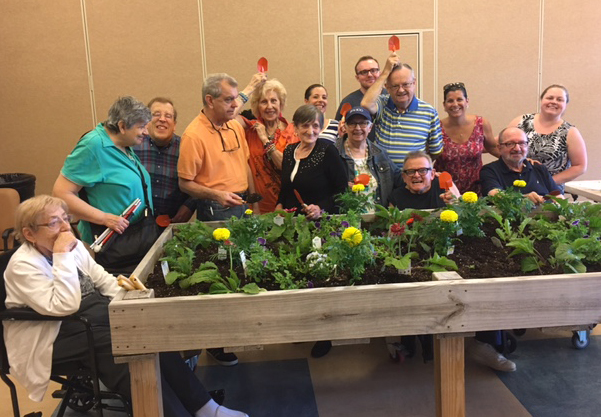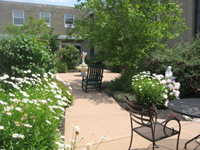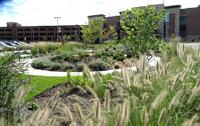Horticultural TherapyHistory and Practice
In the 1940s and 1950s, rehabilitative care of hospitalized war veterans significantly expanded acceptance of the practice. No longer limited to treating mental illness, horticultural therapy practice gained in credibility and was embraced for a much wider range of diagnoses and therapeutic options. Today, horticultural therapy is accepted as a beneficial and effective therapeutic modality. It is widely used within a broad range of rehabilitative, vocational, and community settings. Horticultural therapy techniques are employed to assist participants to learn new skills or regain those that are lost. Horticultural therapy helps improve memory, cognitive abilities, task initiation, language skills, and socialization. In physical rehabilitation, horticultural therapy can help strengthen muscles and improve coordination, balance, and endurance. In vocational horticultural therapy settings, people learn to work independently, problem solve, and follow directions. Horticultural therapists are professionals with specific education, training, and credentials in the use of horticulture for therapy and rehabilitation. Read the formal definition of the role of horticultural therapists. For a comprehensive overview of the practice of horticultural therapy, please read the AHTA Position Paper. To follow the latest media buzz on horticultural therapy, visit our blog. Definition of a Horticultural Therapist
As the American Horticultural Therapy Association strives towards certification for horticultural therapists, public awareness of what is, and what is not, a horticultural therapist is essential for professional recognition. The American Horticultural Therapy Association supports the definition that a horticultural therapist is someone who:
The American Horticultural Therapy Association recognizes that there are individuals without professional credentials who represent themselves as practicing horticultural therapists having completed a certificate in horticultural therapy. While a certificate is of value in providing the horticultural therapy education, a certificate does not provide education in horticulture, human science, nor provide practical experience. The Association does not support the use of horticulture as therapy by individuals who do not have the required educational background nor possess professional credentials. The Association recognizes that there are professionally credentialed practitioners who use horticulture as a therapeutic tool in their practice. Many credentialed professionals have completed a horticultural therapy certificate program. While the AHTA accredited certificate coursework provides valuable education, to develop a thorough understanding of the discipline, coursework in horticulture and human science is necessary. The Association welcomes and encourages, credentialed professionals to pursue professional registration with the American Horticultural Therapy Association. Education for Horticultural Therapists
For those interested in pursuing a career in horticultural therapy, the American Horticultural Therapy Association (AHTA) offers the only recognized credential for horticultural therapists: HTR, Horticultural Therapist – Registered. The HTR credential may be granted after completing a standardized educational curriculum and an internship supervised by an AHTA Registered Horticultural Therapist. This curriculum is built on the foundation of a bachelor’s degree in horticultural therapy, or the minimum of a bachelor’s degree with additional coursework in plant science, human science, and horticultural therapy. The American Horticultural Therapy Association also accredits select certificate programs. Horticultural therapy certificate programs are instructional programs for college credit that are designed to provide a foundation in the theory and application of horticultural therapy for diverse populations. In accrediting these programs, AHTA assures that each program meets nationally-endorsed standards in the profession, and meets the horticultural therapy requirements for AHTA’s voluntary professional registration program. It is important to know that upon completion of a certificate program one is not certified as a horticultural therapist. Currently, certification is not an option for horticultural therapists; however, work is being done to achieve this for all HTRs. A Word About Therapeutic Gardens
A therapeutic garden is a plant-dominated environment purposefully designed to facilitate interaction with the healing elements of nature. Interactions can be passive or active depending on the garden design and users’ needs. There are many sub-types of therapeutic gardens including healing gardens, enabling gardens, rehabilitation gardens, and restorative gardens. What makes a garden therapeutic? The basic features of a therapeutic garden can include wide and gently graded accessible entrances and paths, raised planting beds and containers, and a sensory-oriented plant selection focused on color, texture, and fragrance. Learn more by reading AHTA's characteristics of therapeutic gardens. Frequently, landscape designers collaborate with horticultural therapists to create beautiful spaces that accommodate people with a wide range of abilities. While these gardens may represent the ideal, successful horticultural therapy programs do not depend upon an elaborate garden design. Likewise, a professionally-designed therapeutic garden without a horticultural therapy program is unlikely to deliver to its full potential. To learn more about therapeutic gardens, please explore: American Society of Landscape Architects; Healthcare and Therapeutic Design Professional Practice Network. Therapeutic Landscapes Network, A resource for gardens and landscapes that promote health and well-being. Therapeutic Garden Characteristics, by Teresia Hazen, MED, HTR, QMHP.
Therapeutic Gardens
The Sensory Garden at St. John Neumann Nursing Home, Philadelphia, PA Design for Generations LLC.
Rochester General Hospital Strolling Gardens, Rochester, NY, Zaretsky and Associates.
Buehler Family Foundation Enabling Garden at Naples Botanical Garden, FL. (photo credit: Lesley Fleming, HTR) |

 Horticultural therapy is a time-proven practice. The therapeutic benefits of garden environments have been documented since ancient times. In the 19th century, Dr. Benjamin Rush, a signer of the Declaration of Independence and recognized as the "Father of American Psychiatry," was first to document the positive effect working in the garden had on individuals with mental illness.
Horticultural therapy is a time-proven practice. The therapeutic benefits of garden environments have been documented since ancient times. In the 19th century, Dr. Benjamin Rush, a signer of the Declaration of Independence and recognized as the "Father of American Psychiatry," was first to document the positive effect working in the garden had on individuals with mental illness. To advance the profession, it is important that the public recognize horticultural therapists as professionals with specific education, training, and credentials in the use of horticulture for therapy and rehabilitation. Professional registration informs the public that the horticultural therapist has met the required education and experience to practice horticultural therapy.
To advance the profession, it is important that the public recognize horticultural therapists as professionals with specific education, training, and credentials in the use of horticulture for therapy and rehabilitation. Professional registration informs the public that the horticultural therapist has met the required education and experience to practice horticultural therapy. Academic coursework is the foundation for those considering a career in horticultural therapy (HT). Horticultural therapy education is multidisciplinary and encompasses studies in human sciences and plant sciences, as well as horticultural therapy concepts and techniques.
Academic coursework is the foundation for those considering a career in horticultural therapy (HT). Horticultural therapy education is multidisciplinary and encompasses studies in human sciences and plant sciences, as well as horticultural therapy concepts and techniques. In recent years we have seen a significant upswing of interest in therapeutic gardens. These gardens are specifically designed to address a variety of applications within healthcare, rehabilitative and other therapeutic settings. In fact, the American Society of Landscape Architects maintains a professional practice network of consultants who specialize in designing therapeutic gardens.
In recent years we have seen a significant upswing of interest in therapeutic gardens. These gardens are specifically designed to address a variety of applications within healthcare, rehabilitative and other therapeutic settings. In fact, the American Society of Landscape Architects maintains a professional practice network of consultants who specialize in designing therapeutic gardens.





